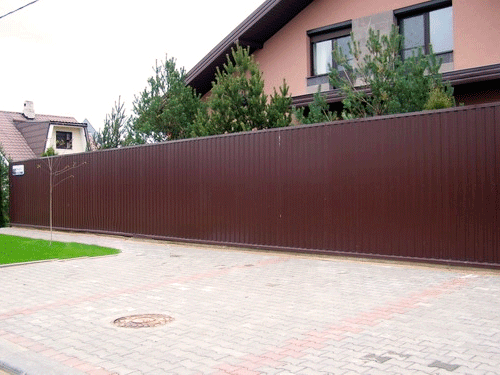Instruction
1
If the design of your home was used sheet metal, it is logical to make him and the fence. By staying on this option, you choose all the basic tasks that must perform the fence:- protection from penetration into the territory of unauthorized persons and animals;
- ease of fabrication;
- relative cheapness;
- wide colour range and minimal costs of its maintenance during the subsequent operation (do not need additional investments on a seasonal painting, repair).
- ease of fabrication;
- relative cheapness;
- wide colour range and minimal costs of its maintenance during the subsequent operation (do not need additional investments on a seasonal painting, repair).
2
The construction start of excavation. Wind load from the fenceand corrugated very serious and therefore supports that need to be placed around the perimeter of the site, must be securely fastened. Depth of holes under the rack can reach up to 150 cm. please ensure that at this depth there are no communications. Making sure that work is safe, proceed to the production of Yam under the rack. With the help of an ordinary drill (hand or power) drill in the ground holes with a depth of 0.9-1.5 m. the Distance between them should be 2-2,5 m.
3
Supports fabricated from pipe (diameter not less than 60 mm) or profile of the "square". The prepared metal rack set in a pitted, pre-pour them in the gravel. Stand position on the perimeter fencing of the territory, dividing it into areas with the same terrain. Height adjust the thickness of the layer of crushed stone, fill in the holes. Align the supports vertically and sebaconitrile.
4
Depending on the height of the installed fence,and select a number of cross progerin to which will be attached to the sheet metal. At the height of the fenceand up to 2 meters is enough to set one flight 2 prozhiliny. Their manufacture of shaped square or rectangle with a wall thickness of at least 3 mm.
Welding attach prozhiliny to installed the metal supports. Cover support and prozhiliny primer.
Welding attach prozhiliny to installed the metal supports. Cover support and prozhiliny primer.
5
Sheet metal install close to prailine at a distance of 5-10 cm from the ground. Using "wave" drill holes in it and the wall profile of square prozhiliny. Through the drilled holes, secure the sheet with screws or rivets. The gap between the lower edge of the sheet and the earth is best to complete the laying of brick or natural stone.
Useful advice
- When installing supports, welded to them broilin be sure to use the plumb and level;
- The rack of the fence, to avoid the ingress of excessive moisture, close the decorative "cap".
- The rack of the fence, to avoid the ingress of excessive moisture, close the decorative "cap".
